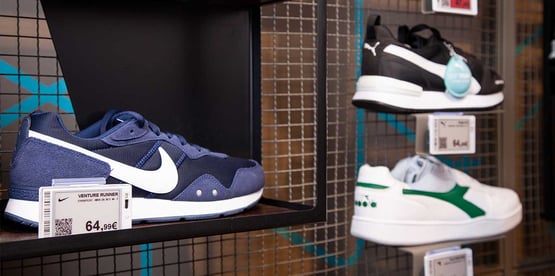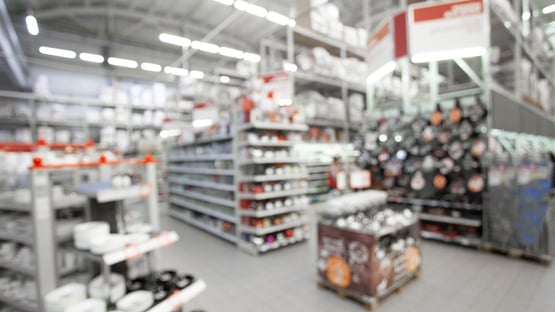The modern sports store has a lot of work to do to communicate with and sell to a customer whose expectations have never been more demanding, particularly since the great shift to digital during 2020.
A growing variety of shopping journeys and different channels employed by the shopper means that every store visit must count, requiring the sports retailer to be more agile in their assortment, allocation, replenishment and promotional strategies as well as heightening the level of consumer information and engagement through instant additional information access.
Pricer is the only dedicated provider of in-store digital shelf-edge solutions that enhance both store performance and the shopping experience. And its solutions sit on a platform of technologies designed to catalyse retail digitalisation, boosted by an ecosystem of partners in areas as diverse as price optimisation, waste management and self-scanning, all of which complement the objective of enabling the shelf to deliver more value for all retailer stakeholders and their customers.
Automated pricing
The value of electronic shelf labels is principally to do with time saved not having to print and replace price tags. Based on 500 price changes per week and two minutes to change each price tag (including printing, sorting and finding the right product) at an hourly cost of €20 that total more than EUR17,000 a year saved.
In addition, because prices can be changed instantly, in real time, they are always in step with the competition, whatever strategy they deploy, which is the best way to protect margins. Moreover, universal price management also guarantees price synchronization across both on- and off-line channels, which meets customer expectations around consistency, and avoids the risk of fines for inconsistency.
Replenishment and efficient in-store supply chain
By using labels with flash and location mapping, finding the right place more easily, the time saved on each item replenished is between three and six seconds.
At a sell-through rate of 20,000 items per day in batches of 10 items, time saved is four seconds. At €20 hourly cost this adds up to a saving of more than €16,000 per annum.
Further time is saved because the problem of putting items in the wrong place is eradicated.
Inventory management
Single-event, instant identification of stock anomalies
• Shelf labels switch to display stock information and flash identifies anomalies
• Shelf labels display in reverse white out of black to show when stock will be available
• Camera vision identifies shelf gaps and machine learning identifies relevant product
Enables reduction in out of stocks, improved inventory control and reduced capital bound in in-store stock.
Promotions
Trying to manage slow-moving stock is a significant drain on resources whereas flash on shelf talkers can draw immediate attention to a promotion without any manual intervention. In trials, the time saved is around 50%. Value is dependent on the extent of shelf talker usage in the store but based on 5% promotional shelf talkers per week across 12,000 SKUs over a two promotional period cuts time by 10 seconds which is an annual saving of more than €3,500 per year based on €20 hourly cost.
Touchless Customer Engagement Using QR Codes and NFC
Customers have become accustomed to the use of QR Codes and many also are familiar with the use of Near Field Communications (NFC) as a route to more information. By integrating these capabilities into every ESL, instant easy access to additional information on a single item can deliver immediate benefits in customer satisfaction, engagement and communication. (See Intersport example below for use of QR Codes)
Advanced benefits using AI-backed analytics
As these processes generate ever richer data and machine learning reveals new insights, all stakeholders can collaborate to optimise item performance even further.
Each of these solutions delivers significant value in their own right. However, integrated with other shelf technologies, new capabilities and benefits become available, setting retailers on the route to a complete view of store and stock status.
Electronic shelf labels and machine vision ensure that each item and category can be allocated the most profitable amount of space and any over stocks dealt with quickly. Other variables can be considered, such as price elasticity, so that existing space allocation can be exploited more profitably.
Electronic shelf labels at sports chain, INTERSPORT
INTERSPORT, the world’s largest sports retailer, has improved customer experience as well as the efficiency of in-store operations using a solution from Pricer.
INTERSPORT, with more than 6,000 affiliated stores in 57 countries, recognised that manual in-store pricing was becoming a time-consuming task for its employees, with markdowns on goods, such as footwear and trainers, applied manually and often during busy sales periods. This not only led to inefficient price management, but it took store associates off the shop floor and away from serving customers, as Aggelos Stefanou, IT Manager at INTERSPORT Greece, Cyprus and Balkans, explained:
“The huge amount of hours spent only on changing the prices, with everything from checking the prices, printing the paper labels and putting everything up in the right place was a big issue for us. We realised that the employees could spend their time better serving our customers and doing other in-store tasks.”
For INTERSPORT, price changes are driven by different factors, such as discounting periods, like Black Friday or seasonal sales, as well as online pricing, digital marketing initiatives and competitors’ campaigns. It wanted to be able to synchronise in-store prices with online activity, allowing it to quickly react and actively manage pricing strategies, while reducing pricing errors or inconsistencies.
The modern ESL solution from Pricer, which delivered around 1,000 SmartTAG HD per store, now provides instant price changes, with pricing now automatically managed in seconds on a daily basis. This not only ensures accuracy and consistency of prices across its sales channels, but it also frees up store associates’ time so that they could focus on value-added tasks, serving customers and enhancing the in-store experience for shoppers; it estimates that every store saves one month of shop staff’s working hours per year thanks to the solution.
The ESLs are also enhancing the experience at the shelf-edge, as they feature a QR code which benefits both store staff and customers. Scanning the code, store associates have real-time visibility of stock, allowing them quickly see what inventory is available and in which size, while shoppers can benefit from endless aisle capabilities, using the QR code to find out more information about the product on display, or place an order should the size or model they are looking for be sold out in store.
Stefanou added: “For stores like INTERSPORT - and the whole retail industry - price management is extremely critical. Today, we perform price controls every morning before the opening to ensure that the prices are up to date. At the same time, we now never have pricing mistakes.”
Originally published on Sports insights on June 14th, 2021.



